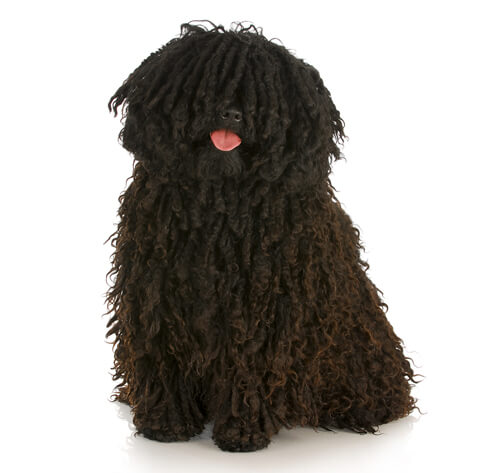
The Puli dog is easily recognised by his trademark coat - long cords, sometimes reaching the ground in length. They can be black, rusty black, white or various shades of apricot and grey in colour. Beneath the coat, this is a sturdy and muscular breed. Adult stand at 40-44cm and weigh 13-15kg; adult females are 37-41cm and weigh 10-13kg.
The need-to-know
- Dog suitable for experienced owners
- Some training required
- Enjoys active walks
- Enjoys walking an hour a day
- Medium dog
- Minimum drool
- Requires grooming every other day
- Hypoallergenic breed
- Chatty and vocal dog
- Guard dog. Barks and alerts
- May require training to live with other pets
- May require training to live with kids
Personality

Lively and animated, Pulis have a tendency to bond with one member of the family. They are friendly, although they will announce visitors at the door and be somewhat reserved with them. They can be stubborn but are quick to learn in training.
History and Origins

The Magyars, one of the many tribes of nomadic Huns that migrated to Eastern Europe, brought Pulis to their native land in the 9th century. These dogs were used to herd and protect their flocks. Over the years they were bred for their ability to work and soon became established in other countries. Today the puli dog breed has adapted to town living as well as working and living in the countryside.
Nutrition and Feeding

Your dog's diet needs to have the right balance of all the main nutrient groups including a constant supply of fresh water. It's important to conduct regular body condition scores to ensure you keep your dog in ideal shape and remember to feed him at least twice daily and in accordance with the feeding guidelines of his particular food.
Exercise

Energetic by nature, the Puli breed needs a reasonable amount of exercise – at least an hour a day for an adult, preferably more - and they are in their element if given free-running time to romp and play.
Other Information

Health and Common Issues
The Hungarian Puli is a relatively healthy, hardy breed. However as with many breeds they can suffer from hereditary eye disorders and hip dysplasia (a condition that can lead to mobility problems). Eye testing and hip scoring of dogs prior to breeding is therefore important.
Best Family Dog Breeds
While many dogs are traditionally thought of as being good with children, all dogs and children need to be taught to get on with and respect each other, and be safe together. Even so, dogs and young children should never be left alone together and adults should supervise all interactions between them.